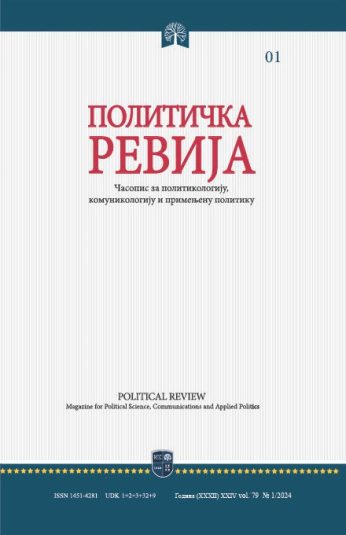Тема броја
БЕЗБЕДНОСТ И ТЕРОРИЗАМ
ВЕЗА ИЗМЕЂУ НИВОА ОБРАЗОВАЊА И ТЕРОРИЗМА
Сажетак
Предмет рада је веза између нивоа образовања и учествовања у тероризму и одговор на питање да ли постоји директна веза између нивоа образовања и тероризма. Наиме, упркос мишљењу јавног мњења да су терористи необразовани, емпиријска истраживања показују управо супротно – да су они у просеку образовани припадници средње класе. Рад најпре сагледава управо та истраживања која указују на везу између високог образовања и тероризма и потом прави преглед различитих теорија које објашњавају ове резултате. Након тога, ауторка користи теорију рационалног избора и генералну теорију напора да објасни своју тезу да је веза између високог образовања и тероризма посредована социоекономским условима у држави, те да не постоји директна веза између нивоа образовања и учествовања у тероризму. На крају рада уместо закључка нуде се неке препоруке које могу да се примене у систему образовања, а у циљу смањивања могућности од појаве тероризма.
Референце
- Agnew, Robert. 2010. „A general strain theory of terrorism“. Theoretical Criminology, 14(2): 131-153.
- Basra, Rajan and Neumann, Peter. R. 2016. „Criminal pasts, terrorist futures: European jihadists and the new crime-terror nexus“. Perspectives on Terrorism, 10(6): 25-40.
- Berrebi, Claude. 2007. „Evidence about the link between education, poverty and terrorism among Palestinians“. Peace economics, peace science and public policy, 13(1): 18-53.
- Bravo, Ana Bela Santos and Dias, Carlos Manuel Mendes. 2006. „An empirical analysis of terrorism: Deprivation, Islamism and geopolitical factors“. Defence and Peace Economics, 17(4): 329-341.
- Brockhoff, Sarah, Krieger, Tim and Meierrieks, Daniel. 2010. „Ties that do not bind (directly): the education-terrorism nexus revisited“. Available at SSRN 1647664.
- Crenshaw, Martha. 1981. „The causes of terrorism“. Comparative politics, 13(4): 379-399.
- De Mesquita, Ethan Bueno. 2005. „The quality of terror“. American journal of political science, 49(3): 515-530.
- Gambetta, Diego and Hertog, Steffen. 2009. „Why are there so many Engineers among Islamic Radicals?“. European Journal of Sociology/Archives Européennes de Sociologie, 50(2): 201-230.
- Gurr, Ted Robert. 1970. Why men rebel. New Jersey: Princeton University Press.
- Hess, Gregory and Blomberg, S. Brock. 2005. „From (No) Butter to Guns? Understanding the Economic Role in Terrorism“. Paper written for World Bank Workshop on Security and Development
- Honaker, James. 2004. „Unemployment and violence in Northern Ireland: a missing data model for ecological inference.“ Presented at the Annual Meetings of the Midwest Political Science Association.
- Huntington, Samuel. 1996. The clash of civilizations and the making of a new world order. New York.
- Krueger, Alan B. and Malečková, Jitka. 2003.“Education, poverty and terrorism: Is there a causal connection?“ Journal of Economic perspectives, 17(4): 119-144.
- Lee, Alexander. 2011. „Who becomes a terrorist?: Poverty, education, and the origins of political violence“. World Politics, 63(2): 203-245.
- Li, Quan and Schaub, Drew. 2004. „Economic globalization and transnational terrorism: A pooled time-series analysis“. Journal of conflict resolution, 48(2): 230-258.
- Li, Quan. 2005. „Does democracy promote or reduce transnational terrorist incidents?“. Journal of Conflict resolution, 49(2): 278-297.
- Ljujic, Vanja, van Prooijen, Jan Willem and Weerman, Frank. 2017. „Beyond the crime-terror nexus: socio-economic status, violent crimes and terrorism“. Journal of Criminological Research, Policy and Practice.
- Makarenko, Tamara. 2012. „Europe’s Crime-Terror Nexus: Links between terrorist and organised crime groups in the European Union.“ Study for the LIBE committee. Brussels: European Parliament
- Makarenko, Tamara. 2004. „The Crime-Terror Continuum: Tracing the Interplay between Transnational Organised Crime and Terrorism“. Global Crime, 6(1): 129-145.
- Merton, Robert K. 1957. Social structure and anomie. New York.
- Nikodinović, Nikša. 2017. Američka nacionalna strategija za borbu protiv terorizma na početku 21. veka. Doktorska disertacija. Fakultet političkih nauka Univerziteta u Beogradu
- Russell, Charles A. and Miller, Bowman H. 1977. „Profile of a Terrorist“. Studies in conflict & terrorism, 1(1): 17-34.
- Sageman, Marc. 2008. Leaderless jihad: Terror networks in the twenty-first century. University of Pennsylvania Press.
- Schmid, Alex P. 2005. „Links between Terrorism and Drug Trafficking: A Case of „Narco-terrorism“?“. International Summit on Democracy, Terrorism and Security. 8: 27.
- Shelley, Louise.I. and Picarelli, John.T. 2005. „Methods and motives: Exploring links between transnational organized crime and international terrorism“. Trends in Organized Crime, 9(2): 52-67.
- Simeunović, Dragan. 2009. Terorizam. Beograd: Pravni fakultet Univerziteta u Beogradu

